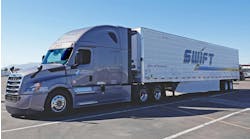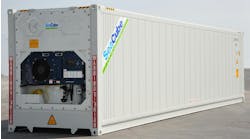OEM evolution: Wabash reenvisions go-to-market strategy
Wabash has an innovative structural technology, a newly unified name—and a unique go-to-market strategy built to elevate both.
Acutherm thermal management products with EcoNex technology are the first example of the equipment manufacturer’s fresh approach, which chief strategy officer Dustin Smith maintains sets it apart from other trailer and truck body OEMs, and shows it’s working on solutions for today and tomorrow.
“Customers are buying into the value proposition Wabash is offering, which is about attacking tomorrow’s problems today,” said Smith, who leads Wabash’s research and development, and business development efforts.
The Wabash executive recently spoke to Trailer/Body Builders about several elements of the company's wide-ranging approach to the market: the Acutherm sub-brand he described as an “intelligent system of thermal solutions;" EcoNex, formerly dubbed molded structural composites (MSC) technology; the “One Wabash" branding initiative—and the possibilities in years to come.
“We’re finding other interesting use cases for the technology, and you could see Wabash going to market someday with non-cold chain products that have EcoNex technology in them, because it’s a structural composite, and we can get rid of steel, wood, and a lot of things that corrode over time with this technology,” Smith predicted.
Acutherm sub-brand
Wabash unveiled the Acutherm lineup in September, saying it boasts “enhanced levels of thermal efficiency and management” for hot and cold applications. The initial offering includes refrigerated trailers and freight delivery bodies with EcoNex, sanitary tank trailers, and refrigerated inserts for cargo vans like Ford’s E-Transit.
Smith stressed not all Acutherm products feature EcoNex. The line includes products with the “breakthrough” composite technology, trailers with traditional insulated sheet-and-post construction, and other reefer products. “It’s like ‘intel inside’ on a computer,” Smith explained. “We use that analogy because it resonates with people.”
The Acutherm sub-brand creates a system of componentry, products, and solutions that “intuitively maintain thermal integrity over time,” Smith said. And the company’s “clean-sheet” approach allowed it to design reefer trailers utilizing a “transformative” technology that attacks multiple pain points simultaneously.
“Breakthrough value for the customer rarely comes from changing one thing,” Smith insisted.
EcoNex technology
Wabash first introduced EcoNex technology in a prototype reefer trailer in 2016 at the American Trucking Association’s Technology and Maintenance Council meeting. It launched a reefer truck body with EcoNex, then branded as MSC, in 2021, with a “large grocery retailer” placing an initial $10 million order for delivery this year.
“We remain on track with our plan to scale our innovative molded structural composite technology within refrigerated vans, truck bodies, and other transportation logistics and distribution-related products,” Brent Yeagy, Wabash president, CEO, and director, said last November in an earnings call. “We believe we have a unique technology … that has the ability to disrupt the broad cold-chain product market.”
Yeagy forecasted increased MSC vehicle production in the call. Then Wabash revealed a $20 million investment in its Little Falls, Minnesota, plant in August intended to expand EcoNex production capacity. “Although Wabash developed EcoNex with trailers in mind, its scalability across our portfolio is substantial,” Yeagy said.
Smith describes EcoNex as an “ingredient brand.” It’s greatest value proposition, initially, is in the cold-chain space due to its “superior thermal properties.” But the composite also is lighter, stronger, and more corrosion-resistant than other materials used in trailer and truck body construction; and Wabash’s ongoing R&D promises further asset-life and sustainability gains, he said. “Because of this technology, we might be able to develop further technologies that, when you add them together, generate synergistic benefits,” Smith said.
Going to market
Wabash in February dropped its legacy trailer brand names, including Brenner, Bulk Tank, Supreme, Transcraft, and Walker—which Smith said many people still didn’t realize were Wabash products—and united all of its trailers, truck bodies, process systems, and parts and services under the Wabash name, better identifying the company’s “massive” portfolio, which generated $1.8 billion in sales last year, Wabash reported.
The introduction of Acutherm is the next step in that evolution.
While Wabash no longer will go to market with brands based on vehicle type, as is common in the industry, divisions—or “sub-brands”—still are a useful way of grouping products with similar properties or applications. “Rather than going to market the old way, we’re looking at the entire portfolio that Wabash provides, from first to final mile, and saying, ‘You know where we could us a sub-brand? As a way to roll all of our thermal management products into one lineup, and going to market with Acutherm,’” Smith clarified.
Exponential benefits
Wabash started with a cold-chain lineup because of EcoNex’s compelling thermal properties, and because it sees the space “growing above market averages over the next decade,” Smith said. “So it’s an important space to be in, and our customers feel that way as well.” And because customers see the company radically adjusting its approach to better serve their needs, they’re more willing to collaborate with Wabash “to create new ways of improving their ability to serve their markets in more efficient, sustainable, and innovative ways—and we continue to invest the resources that are required to deliver,” Smith asserted.
With Acutherm, they’re able to serve reefer carriers, but they also can equip larger multi-line carriers with diverse freight and transportation modes, Smith said, and partnering with Wabash provides “instant access” to what the company offers today, visibility into the technology it’s developing for tomorrow—and the power to help shape it. “By working together, we can find more interesting solutions than if Wabash kept its nose down, working by itself, and then offered something to the world wondering if the market will actually like it.”
Smith also suggested EcoNex technology, and Wabash’s long-standing commitment to advancing sustainability, puts it in a lead position as more companies search for ways to mitigate their carbon counts, whether it’s by reducing reliance of diesel-powered transport refrigeration units, saving weight, or improving durability. “You can appreciate how that plays well into anybody’s sustainability calculator—fewer emissions, less diesel consumption, and a smaller footprint,” Smith said.
“Longer asset life leads to less waste and lowers capex, and that’s before you factor in $5 diesel. So there is a big, compelling story.”
Moving forward
Wabash combined its tank and refrigerated trailers in one suite of products because thermal performance matters in both. The company’s tankers didn’t change with the Acutherm launch, Smith said, but one day could feature EcoNex, which also can keep hot products hot, or help separate temperature-sensitive systems.
“Are there interesting value propositions like isolating engine heat on one side of the space, while keeping freight cold on the other? Absolutely,” Smith said. “And with [electric vehicles] coming online, that changes where heat originates. Rather than a diesel-burning engine generating heat under a hood, a battery might be generating heat somewhere else. We have to account for that if we’re thinking five years into the future.”
Going forward, Wabash will continue to introduce cold-chain products under the Acutherm name, but EcoNex will begin to “penetrate” other product lines as the company scales production and builds out sub-brands based on application and customer specification, Smith said. “We’re investing heavily in the technology now, at various facilities and in various parts of the company.”




